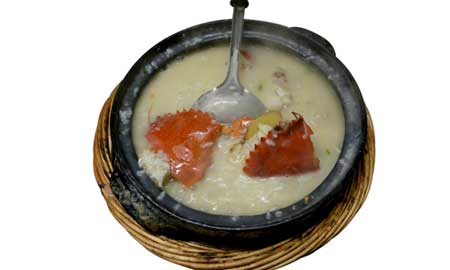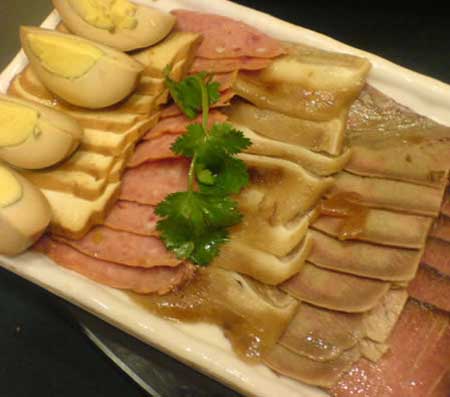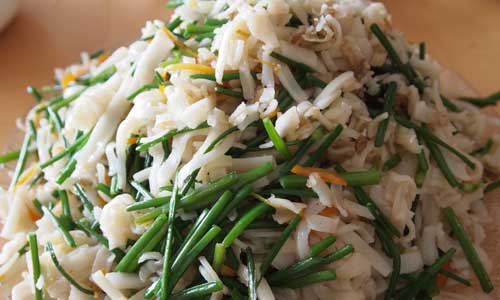The beauty of the lesser-known Cantonese culinary tradition
Diners enjoy Chaoshan porridge in a Chaoshan cuisine restaurant.Photo: Lu Yun/GT
Located on the border of Guangdong and Fujian provinces in southeast China, the Chaoshan region has been dubbed the "Pearl of the South China Sea." Set against the backdrop of stunning mountains and facing the sea, Chaoshan geographically includes the cities of?Chaozhou,?Shantou?and?Jieyang.
Affiliated to Cantonese cuisine - one of the eight major culinary schools in China - Chaoshan food is characterized as light, fresh, crisp and sweet tasting.
The main ingredients for Chaoshan meals include fresh seafood, poultry and vegetables - all easily sourced within the area.
Doing porridge
Eating porridge in China is as traditional as drinking tea, and the Chaoshan variety mainly uses rice and seafood as a base.
The porridge has a particular name, "mi," in Chaoshan, and it has to be cooked on a high heat until the rice crackles and breaks in half and the water turns gelatinous.
When the porridge gets thick and sticky, the Chaoshan chef will add fresh seafood including scallops, shrimps, crabs, and even abalones.
"The authentic mi tastes a little hard, so we boil it longer to make it softer and stickier so that it suits the Shanghainese palate," said Liu Qian, the owner of Chaoshan Porridge restaurant.
To make this hearty meal, first cook the rice with soup-stock in a casserole dish for at least 30 minutes, then add the seafood in for about 5 to 10 minutes. You should keep stirring the mix to avoid the rice sticking to the bottom.
The selection of ingredients also plays an important role in the porridge. Restaurants will choose first-class rice from the northeast of China, which boasts both a chewy and savory flavor. Instead of plain water, restaurants use soup-stock with a few individual "secret" ingredients to cook the rice, which helps bring out more flavor in the porridge. According to Liu, many businesses will also buy the seafood direct from Guangdong Province. "Different species of seafood suit different dishes, and our top recommendations are scallops."

Fresh seafood is added to Chaoshan porridge.Photo: Lu Yun/GT and courtesy of AZ
Home of the braised
If a chef told you that the braised dish you were enjoying was cooked in a huge pot that was never cleaned or had fresh soup base added, how would you feel? You may be tempted to spit it out, but this is actually the traditional way of cooking so-called braised "varieties" (usually meat, tofu or eggs) in Chaozhou.
Chaozhou is well-known for its three edible "treasures": seafood, kung fu tea and these braised varieties. Cooked in a marinated broth stew made with various Chinese herbs, braised varieties often include unusual parts of poultry such as the head, liver, feet or gizzards of geese.
Compared with seemingly similar dishes such as Cantonese barbecue meat, the Chaoshan braised varieties are less oily and more chewy, soft and savory.
"The key to good braised varieties lies in the marinated broth stew, the recipe for which most restaurants keep unchanged," said Liu. "As the flavor becomes more uniform and bland, our chef will add herbs and other ingredients to liven it up." The herbs used usually include orange peel, tangerine peel, amomum seeds and licorice.
Chaoshan cooking is also characterized by the use of ingredients such as galangal (from the ginger family), Chinese basil, and pickled vegetables.
Sauces used to accompany these dishes include Puning soybean sauce, Shantou sweet-and-spicy sauce, garlic and white vinegar sauce, and fermented fish sauce. Each sauce is designed for particular dishes, according to Lawrence Lo, founder of Etiquette Training Consultancy, and TV chef personality.
"As the Chaoshan region lagged behind economically to the more robust Pearl River Delta region in central Guangdong, the former is still relatively isolated and many old traditions remain," Lo told the Global Times.
Fishy name
Don't be fooled by the name, fish rice - this dish contains no rice whatsoever. It is sea fish boiled in salty water. In Chaoshan, fish is so well-regarded that it often takes pride of place at many meals. The dish shares similarities with Japanese sashimi, in that the fish rice creates a cool and tender taste in mouth because of being kept in the refrigerator before eating.
The dish originated with fishermen using ancient preservation techniques in Chaoshan. The men would boil the fish on the boat as soon as it was caught, and then scatter a thin layer of coarse sea salt over it before hanging it up to dry.
Today, families and restaurants will boil the fish in salt water. However, be careful not to soak the fish in salt water for too long beforehand because this decreases its savory, smooth taste.

Braised dishes. Photo: Lu Yun/GT and courtesy of AZ
Rice time
The name of this dish, Char Kway Teow, is the literal translation of the way the dish is prepared: stir-fried rice strips.
As one of the most representative dishes of Chaoshan, it has gone through many changes throughout the whole of Southeast Asia where it has been readily adapted. These include the addition of various meats and sauces.
As it is normally a rather plain dish it is often served with a side plate of chili paste to spice up the flavor.
Lawrence Lo told the Global Times his own way of cooking this speciality. Using rice pulp, thin layers of rice sheets are steam cooked. Once ready, these rice sheets are cut into different shapes and sizes, the most common being to cut them into long strains of noodles or strips. Stir-fry these strips over a high heat in a wok. Chinese scallion and diced garlic are added to create this simple vegetarian staple.
Where to dine
Chaoshan Porridge 潮汕砂锅粥馆
Add: 784 Dingxi Road 定西路784号
Tel: 6116-9237
Chaodai Chaoshan Cuisine 朝代潮菜馆
Add: 5/F, Channel 1, 151 Changshou Road 长寿路151号调频壹广场5楼
Tel: 3131-5096
Dayouxuan Jingxizhongcai 大有轩精细中菜
Add: No.2, Lane 1829 Hongqiao Road 虹桥路1829弄2号
Tel: 6275-7978

Stir-fried rice strips Photo: Lu Yun/GT and courtesy of AZ